There are lots of types of puzzles you can use in your D&D games but logic puzzles are by far the easiest to integrate. This is because logic puzzles are either based on statements or numbers. And what is D&D really other than a bunch of statements and numbers?
In this article we’ll show you a lot of logic puzzle examples, how to use them, and we’ll look at some of the best illustrated logic puzzles for your D&D game. So let’s dive right in.
D&D Logical Statement Puzzles
The first type of logic D&D puzzles is really easy to incorporate in your game and a lot of fun. But they should be used very sparingly or your players will get bored eventually. (If you wish to see the illustrated puzzles just keep scrolling) For example:
I have a pot of potato soup. The following statements are true:
- All potatoes in the soup are mine.
- No potatoes of mine, that are new, have been boiled.
- All my potatoes in this pot are fit to eat.
- No unboiled potatoes of mine are fit to eat.
Are there any new potatoes in this pot?
Answer: ‘No, there are no new potatoes in the soup’. The players can reason this out by following the logical statements. If they can’t figure it out, have them roll intelligence checks and give them hints. You can give hints by connecting two logical statements such as:
All the potatoes in the soup are mine + No potatoes of mine, that are new, have been boiled = All the potatoes in the soup that are new, have not been boiled.
The problem with these puzzles is that the DM must be skilled at propositional and predicate logic. If you’re not, these puzzles will confound you as much as they do the players. So they are tricky in that respect.
On the other hand, if you are comfortable with these types of puzzles, you can weave them into your story very easily. Those new potatoes might be cursed and the players need to find out if there are any in the soup they just ate. It takes virtually no effort integrating these types of logic puzzles into your D&D game.
D&D Logical Number Puzzles
The next category are number puzzles for D&D. Numbers represent a type of logic. The main reason for using them in D&D is because numbers are so very clear. To math problems there is only one correct answer, so there can be no discussion about whether players have figured out the puzzle. And players already know the rules to math so the DM will have a lot less explaining to do which speeds up the game. For instance:
PPQ
PQQ
QQQ
——- +
876
In the sum above, P and Q each represent a digit. What is the value of P + Q?
Answer: 5. (P = 3 and Q = 2)
While this is an easy puzzle you can quickly throw at your players the problem with logical math puzzles in D&D is that it is very obvious to players they are solving a math problem. It’s harder to integrate these types of puzzles into your game. And as a result, your players will feel this puzzle breaks immersion. If you want to know how to do these logical math puzzles the right way, read our article on D&D math puzzles.
Illustrated D&D Logic Puzzles
Logic puzzles are a dime a dozen. The real challenge is integrating logic puzzles into your D&D game so players feel the puzzle has a natural place in your setting. Having beautiful illustrations of fantasy themed puzzle pieces players can manipulate helps a lot. But you also need to have a story that places the puzzle solidly in your world and gives players a reason for solving it.
Here’s an example of a logic puzzle by Paul Camp that does a beautiful job at immersion.
With Dungeon Puzzles your players wish to explore a monster-infested dungeon from which only one person has ever escaped alive. This person was driven insane by one of the monsters but with the help of a detect thoughts spell the players were able to gather clues to its layout. Through the detect thoughts spell you learn the piece of the dungeon map, you were able to draw, are in the correct place but they are facing the wrong direction.
The players must lay out the entire dungeon using puzzle piece which come in 4 by 4-inch printable tiles or digital images for virtual tabletop use. By rotating the images in their place, they are able to discover the dungeon layout. This gives them both a map of the dungeon but once they finish this puzzle it immediately serves as the in-game map they can place their tokens on.
Scrambled D&D Logic Dungeon Puzzle:
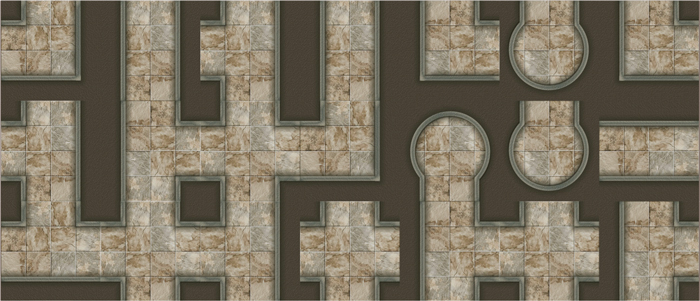
Solved D&D Logic Dungeon Puzzle:
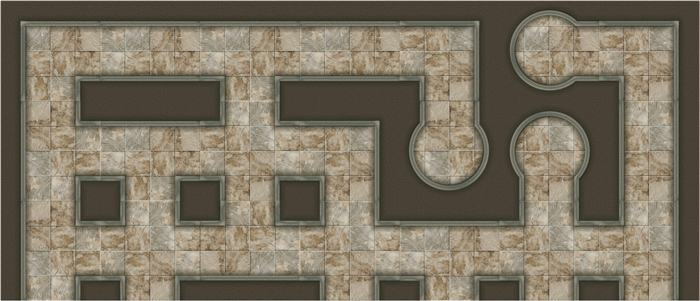
So your players finish the puzzle and can start exploring right away. That’s brilliant! We’ve never seen any other puzzle designer do this and, in our opinion, it puts Paul’s puzzle designs in a league of their own.
And this isn’t the only immersive and innovative logic puzzle design Paul’s created. There’s something new to everything he creates. If you wish to see all of his work, check out our page that holds all of his puzzles for D&D, many of them logic puzzles.
More Logic Puzzles for D&D That We Like
Here are a couple of other options. All of these puzzles are based on logic and work well with any D&D campaign.
Door Puzzles
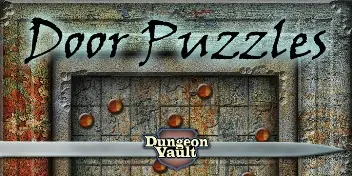
Door Puzzles can be placed onto any door to instantly change it into a challenging puzzle. You simply pick a puzzle from the stack of 20 premade setups, hand your players the key pieces and sit back while they solve the challenge. Of all the puzzles we’ve seen this one is among the easiest for DMs to setup. Door puzzles comes in printable and VTT format.
The rules are simple. Each puzzle door has a grid and a number of pegs. Players must place the key pieces over the pegs to fill out the grid. Sounds simple enough right? But the hard part is that players get ALL the key pieces to choose from. And selecting the right combination requires a lot of logical reasoning.
We found door puzzles has a nice flow of discoveries. And players can work at solving it simultaneously. You can also view this puzzle from all sides which comes in very handy if your players are sitting around the table. Finally, you can create your own puzzles with this system. So you can create an infinite amount of puzzles if you wish.
All the mentioned puzzles and many more are in the Puzzle Bundle. So be sure to check it out!
Potion Puzzles
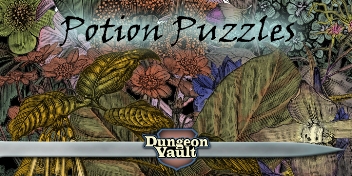
Potion Puzzles took us by surprise. We were expecting a series of simple potion themed puzzles. What we got was a puzzle system that can also double as a complete system for creating magical items in your world. But you don’t have to. Potion Puzzles gives you all the creative control as a DM while adding a massive amount of flavour.
Collecting ingredients, finding potion formulas, and brewing perfumes, dyes, polishes, inks, and of course potions are all a part of solving the puzzle. You can sprinkle ingredients and formulas throughout your campaign. When your players manage to solve the puzzle, create their very own potion and use it, it’s much more significant to the story.
Magical inks can be used for scrolls, dyes for creating magical robes and so on. In short, we got more with this potion puzzles then we thought possible with such an elegant system.
Lock Puzzles
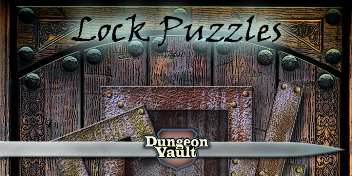
Lock Puzzles can be placed onto doors, ancient tomes, chests, and anything else you wish to secure really. The system is brilliantly easy to use and set up.
The pack comes with nine basic puzzles that each have three pieces. If you wish to create an easy challenge, just place one basic puzzle on a door. But start combining these basic puzzles, and they become increasingly difficult to solve. For intstance, if you place all nine puzzles on the same door the average group might spend about half an hour solving the puzzle. Place a single basic puzzle on a door and they’ll solve it in seconds. Oh, did we mention there are over 500 ways to combine these nine basic puzzles? So don’t worry about replay value! Door puzzles comes in printable and VTT format.
As you can see, there’s a great variety of logic puzzles to choose from and you can find them all in the Puzzle Bundle!
Dark Ulf is the founder and editor of DNDpuzzles.com. When not writing for DNDpuzzles he travels the multiverse and destroys demons with a crossbow in one hand and a crossword in the other.
We hope this site inspires you to put more puzzles into your D&D games.


